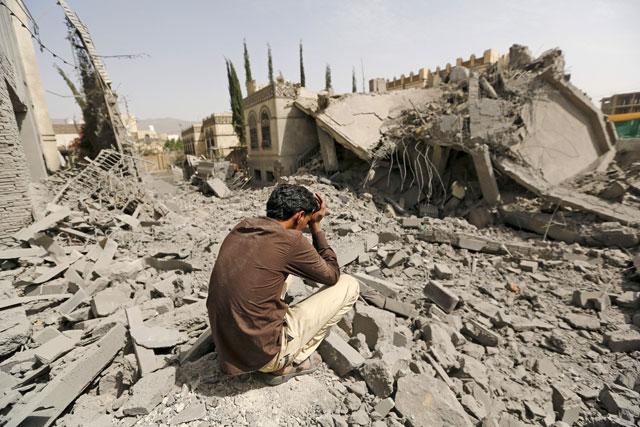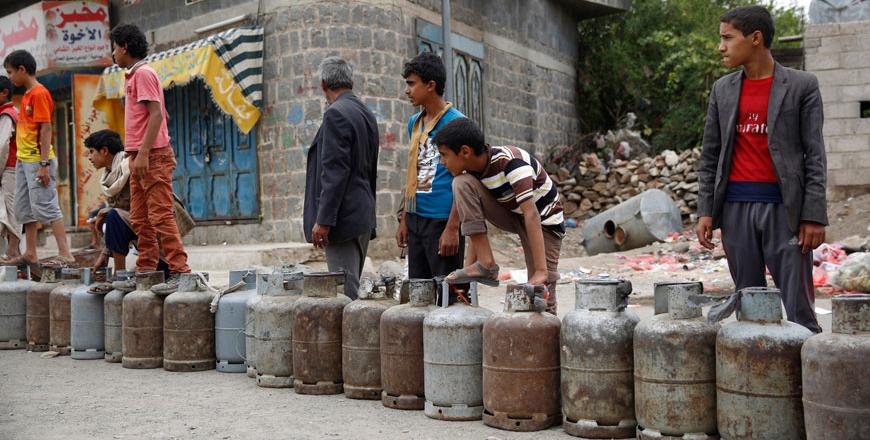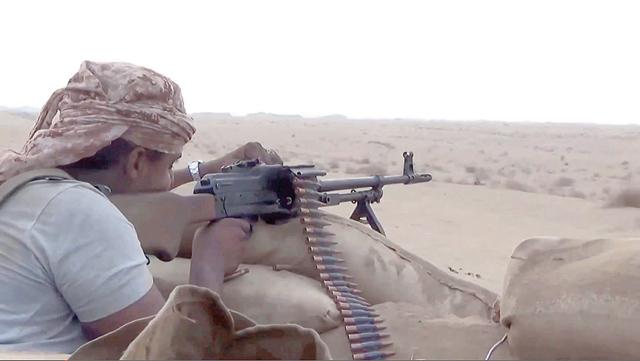You are here
Yemen’s lifeline Hodeida Port stifled under ‘de facto’ blockade
By AFP - Mar 25,2018 - Last updated at Mar 25,2018

A guard sits on the rubble of the house of Brigadier Fouad Al Emad, an army commander loyal to the Houthis, after air strikes destroyed it in Sanaa, Yemen, on June 15, 2015 (Reuters photo)
DUBAI — Yemen's rebel-held Port of Hodeida, a lifeline for a war-battered country dependent on food imports, remains "a wasteland" three months after a Saudi-led coalition said it lifted a blockade.
The assessment by humanitarian and port officials comes as Saudi Arabia and its regional allies push into the fourth year of their military intervention in Yemen.
The operation, launched in March 2015 with the goal of rolling back Iran-backed Shiite Houthi rebels and restoring Yemen's internationally-recognised government to power, has contributed to what the United Nations calls the world's worst humanitarian crisis.
The UN Security Council warned on Thursday that conditions in Yemen are deteriorating and having a "devastating" impact on civilians, with 22.2 million now in need of humanitarian assistance.
The status of Hodeida, the country's largest seaport and gateway to the majority of its aid-dependent population, offers a window into the nation's dire plight.
In February, food imports were half of the monthly national requirement, according to the United Nations agency for humanitarian affairs.
The world body said those food shipments, critical to a nation on the verge of famine, were "the lowest" since the UN began inspecting cargo in May 2016.
Broken cranes
The once-bustling Port of Hodeida now receives a trickle of deliveries, with some ships entering only to remove empty containers and haul them away.
"Hodeida should be supporting more than 20 million Yemenis. It should be the source of at least 70 per cent of all imports to Yemen," Suze van Meegen, a protection and advocacy adviser with the Norwegian Refugee Council, told AFP.
"Instead it's like a wasteland."
Van Meegen, in late February, visited the port for a firsthand view.
AFP requested permission from Hodeida Port authorities to visit, but has not yet been granted access.
"The most striking thing at the port is the destruction of the five gantry cranes," van Meegen said, referring to infrastructure bombed by coalition warplanes in the first six months of their intervention.
The old cranes are now obstacles to movement at the port, and the storage area where containers were once stacked four high is largely empty, she said.
Some 5,000 day labourers have been let go since the bombing of the cranes, according to port authorities.
Van Meegen said that four mobile US-purchased cranes delivered in January — while welcomed by humanitarian groups — do not have the same capability as the old ones.
"The cranes destroyed in 2015 could transport 30 containers each hour," she said. "The four mobile cranes delivered by the US will help with offloading very small quantities of cargo."
The truck-mounted cranes have an offloading capacity of 60 tons but cannot necessarily reach a large container ship, said Robert Foley, a US-licensed chief mate who has sailed on numerous container ships.
He said they are "much slower and more laborious than the traditional gantry crane".
"If the ports lose their ability to operate the gantry cranes, it stops or slows down the rate of cargo operations," Foley told AFP.
Ships at sea
Fuel deliveries amounted to only 24 per cent of Yemen's needs in February, while food met 51 per cent, causing sharp price rises of both.
"For whatever reason, the amount of food and fuel required to meet needs in Yemen is not coming in through Hodeida and it is likely there are some deliberate actions being taken to cause it," said van Meegen.
"We can't say the blockade is in place. The de facto blockade is still in place."
The biggest obstacle, according to authorities at Hodeida port, is out at sea.
"There is only one authority which has the power to give permission for the ships or prevent them," Port Director Dawood Fadel told AFP.
"That is the coalition warships."
In November 2017, the coalition tightened a blockade of Yemeni ports in response to a rebel ballistic missile attack that targeted Riyadh International Airport.
That embargo was eased under international pressure in December for a 30-day period, extended another 30 days, then left in apparent limbo when it expired February 18.
Colonel Turki Al Malki, spokesman for the Saudi-led coalition, said on Saturday that the port was "fully open" and carrying out inspection procedures in cooperation with the UN Verification and Inspection Mechanism.
"The coalition cooperates closely with UNVIM to ensure a safe and regulated environment for maritime shipping, both commercial and humanitarian," Malki said.
He accused the Houthis of levying fees on critical goods to fund their war chest and Iran of smuggling in weapons for the rebels.
The inspection mechanism — established to ease coalition concerns of arms shipments — clears cargo in Dubai, Salalah in Oman and other regional ports before vessels are allowed to proceed.
All ships must ultimately pass through the coalition's fleet.
As of March 15, there were six vessels awaiting coalition clearance to dock, nine cleared to enter and four unloading, according to the UN.
"Ships are still being allowed to sail to the port and discharge their goods but it's a lengthy and complicated process through the Saudi authorities," said van Meegen.
Related Articles
UNITED NATIONS — A World Food Programme (WFP) ship carrying humanitarian aid offloaded its cargo in Yemen on Wednesday, the United Nations s
SANAA — Warplanes from a Saudi-led coalition hit Yemen's Red Sea port of Hodeida on Tuesday, and officials there said the raids destroyed cr
DUBAI — The UN mission in Yemen's rebel-held port of Hodeida expressed "great concern" on Tuesday over claims it was being used for military













